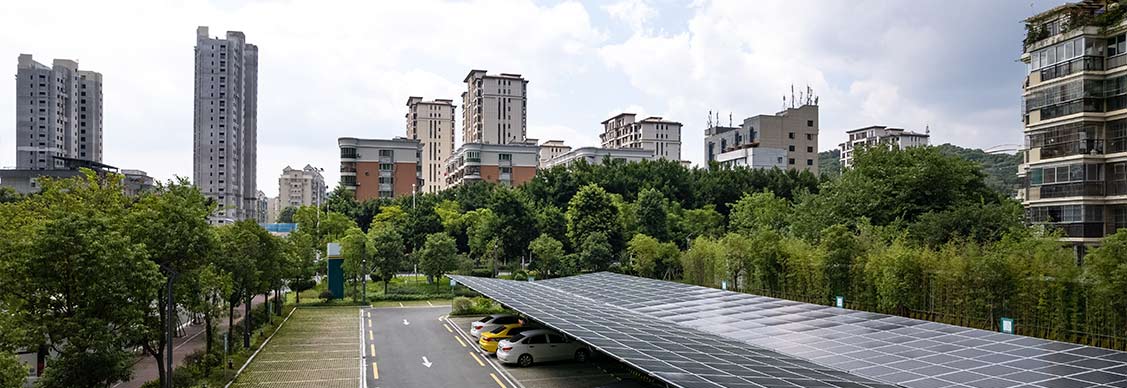How innovative financing is helping cities decarbonize
Tourist taxes and green bonds are funding critical upgrades to energy infrastructure
With carbon reduction deadlines on the horizon, urban authorities are finding new ways to raise the investment needed to upgrade outdated energy infrastructure.
On average, cities are responsible for 78% of the world's energy consumption and produce over 60% of greenhouse gas emissions, much of it from transportation and real estate. Switching from fossil fuels to renewable energy, as well as improving energy efficiency, will be critical to cutting emissions in the coming years to meet net zero targets.
Barcelona, which aims to be carbon-neutral by 2050, is reallocating €100 million ($108 million) from its tourist tax to a fund that will install heat pumps and solar panels in state-owned schools.
Toronto and San Francisco, which are targeting carbon neutrality by 2040, are issuing municipal green bonds to bankroll low-carbon and clean energy projects.
"Climate-progressive cities are adopting more ambitious, alternative funding approaches because they recognise the magnitude of their challenges,” says Jeremy Kelly, Cities Research Director at JLL. “They want to embed the decarbonization journey into deeper partnerships between different stakeholders within a city.”
Cities seek to bridge funding gaps
Tightening national and state regulations and increasing pressure from local populations are accelerating the urgency of upgrading energy infrastructure.
Yet as cities grapple with ongoing technical challenges such as lengthy utility backlogs and a limited supply of grid hardware, financing hurdles are equally significant.
According to McKinsey, the investment needed to deliver on the global energy transition between 2021 and 2050 is estimated to be US$275 trillion, or US$9.2 trillion per year.
A study of 362 European cities from the European Commission’s Joint Research Centre found that the majority cite economic barriers as their main challenge to carbon reduction goals, with conventional public investment or EU funding unable to bridge the funding gap.
"Funding is a significant barrier to upgrading infrastructure. City authorities often need assistance in accessing grants and loans, and in strategically layering different financial solutions to implement projects,” says Kristy David, Senior Vice President, Clean Energy and Infrastructure at JLL.
Combining new funding sources with traditional measures such as carbon taxes can help cities work around limitations on public sector financing and mobilize existing funds.
“Funding raised at a city level can complement national funding mechanisms that require state or local co-investment, while mechanisms like a tourist tax can generate funding without burdening constituents,” says Robert Anderson, Senior Vice President – Clean Energy & Infrastructure at JLL.
Corporate surcharges are another means to raise critical funds and engage businesses in local initiatives. In Paris, employers contribute payments based on employee salaries to fund public transport system upgrades. In the U.S., Portland raises $90 million annually through the 1% Clean Energy Surcharge paid by large retailers on their sales, exempting essentials like groceries and medicines.
“Funding approaches depend on a city’s governance structure and legal pathways for financing,” says Phil Ryan, Director of Global Research, City Futures at JLL. “Mechanisms that drive behavioural changes – such as promoting active transport and reducing car travel – are also important to reduce the cost of decarbonizing systems. Cities are using these multiple levers to drive the transition to a low-carbon economy.”
Denver's Climate Protection Fund, for example, allocated $57.7 million in its first year to projects that support greener infrastructure, including e-bike libraries for essential workers and workforce development in the green job sector.
While some cities are opting for mandatory financial contributions, other schemes are looking to voluntary investments.
E.ON's crowdfunding platform brings together municipalities, local banks, and citizens to develop new energy infrastructures like solar PV parks and wind projects.
"While some environmental policies may encounter pushback due to their cost to people or businesses, more innovative initiatives are looking to engage communities’ hearts and minds,” says Kelly. “Encouraging local stakeholders to come together and actively participate in shaping and funding new renewables projects can unlock the financial and environmental benefits for all.”
Cross-sector collaboration is key
Public-private partnerships are instrumental to accessing the expertise and resources required to upgrade energy infrastructure.
“Cities’ decarbonization efforts are still haphazard. Some cities are reticent to change because they don’t want to lose competitiveness to those with looser environmental regulation,” says Ryan. “Clear guidance and incentive structures that make everyone feel like they have skin in the game – especially the private sector – can help drive progress.”
For instance, Washington DC’s Metropolitan Area Transit Authority leased space at four metro stations for an investor to develop and operate solar-powered carports in one of the country’s largest community solar installations. The partnership will generate $25 million in lease revenue over 25 years while the developer benefits from selling clean energy.
"Municipal authorities require private sector expertise to manage day-to-day operations and associated risks in new infrastructure,” says David. “We’re seeing evolving partnerships with asset monetization models that engage businesses to help implement these efforts.”
In the coming years, public-private partnerships will need to become more common to ensure cities accelerate their decarbonization progress and hit their goals, Anderson believes.
“Given the scale of the decarbonization challenge, the timescales involved and the types of solutions needed, local governments must engage advisors and private sector partners across the infrastructure ecosystem,” he says. “Those pioneering cities that get it right will see earlier and sustained benefits.”
